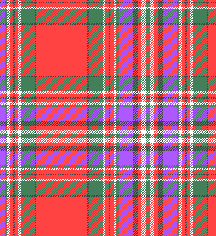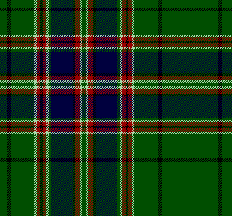
The Clan of "Sons of the Far Land"(?).

It is said the Gaelic for MacFarlane is MacPharlain, sons of Parlan, and Parlan is Anglicised in one form as Bartholomew. Or that it is from the Old Irish Partholon which exists as a name possibly with some connection to the Hebrew name Bartholomew. Or is it more straightforward than that? Is Pharlain or Farlane just simply "Far Land"? One MacFarlane source says, this is so.
Some references say a person called Parlan inherited the property Arrochar, on Loch Long, and was founder of the clan. Other references say Duncan, 6th Chief of the clan, obtained the land from the Earl of Lennox and in 1395 subsequently gained many adjoining lands by marriage. On the death of the last of the Earls of Lennox, MacFarlane claimed the title and lands. Clan MacFarlane has been associated with Loch Long and the Loch Lomond district ever since but their last chief to reside in Scotland died back in 1767.
In the 16th and 17th Centuries the Clan was deprived of name and land by proscription. Many of the clan left for Ireland and America. The last chief is believed by some to have died in America. The Clan has been chiefless and landless for well over a century.
Now for an antipodean episode in the history of MacFarlane Clan folk.
The English authorities used Australia (Botany Bay and Port Phillip), Van Diemans Land (now Tasmania - where the notorious Port Arthur penal settlement was located), as well as Norfolk Island, as penal colonies. Criminals and undesirables from Scotland, Wales and Ireland as well as England, were despatched to these colonies. A form of banishment which caught up all sorts of people from the British Isles. One group were a boat load of folk named MacFarlane and Nolan.
The story goes that a ship carrying the MacFarlanes and Nolans sailed from Australia to the south western coastline of the South Island of New Zealand. This is a region of Fjords (called Fiordland now) where sheer mountains rise thousands of feet above deep inlets. Where there can be incessant rain and waterfalls cascade down the cliffs into the Tasman sea. Where biting insects called sandflies have a voracious appetite that makes life miserable for many people even to this day. The sailing ship sailed close to the shore but never went close enough to moor or anchor and the MacFarlane's and Nolan's, men women and children, were simply manhandled over the side of the ship and left to swim ashore whether they could swim or not. No boats were lowered to assist them and the ship just sailed on abandoning the folk to fate. True castaways. Who knows how many drowned or perished through hypothermia prior to slipping under the surface. How many made their way ashore safely? The women were weighted down by voluminous dresses of the day. Some did survive and today there are still descendants of these folk in New Zealand, even in the Fiordland region.
This treatment ties in with deprivations metted out to Clan MacFarlane over the centuries. Also with the fact that some MacFarlanes went to Northern Ireland, as Nolan is a name from Northern Ireland and Nolans were their compatriots in this mistreatment. But is there something deeper about the location of this part of New Zealand? Why were they not abandoned elsewhere? Perhaps deposited at one of the ports such as Charleston further north up the Westland coast? Does this southwestern region actually have an ancient link to Clan MacFarlane? Should we really say Clan MacFarland, sons of the "Far Land". Perhaps it has little at all to do with the name Bartholomew. Perhaps the name MacFarland was not acceptable until some time after the 14th century when the orginal reason for the initial banishment had lost some of it's stigma. Perhaps the link to Bartholomew and being sons of Parlan was a useful cover, obscuring the link to the Far Land?
If you read the saga of Taine RuaridhMhor, the big cattle owner, who is said to have been banished from Scotland with family and kinfolk during the reign of Alexander the 1st of Scotland, there could be more of a mystery with some answers bearing on why the abandonment took place in this region. Had the location, if not the actual method, been requested? Does Fiordland, and indeed Westland and other parts of New Zealand have an ancient link to Clan MacFarlane? Some say even a pre-Maori link. Perhaps a link with the Waitaha, Moriori, Turehu and Patu-pai-arehe folk of Maori legend? These people were not mythological. The folk involved in this saga are pre-surname use. They would not have used names in the sense of surnames while in New Zealand, and even the name of the land (likened by them to Thule (toolee)*) was not New Zealand or the Maori Aotearoa. Even after some young men returned to Scotland and some of these stayed on, surnames were not in general use.
A lady of Clan MacFarlane origin, resident in New Zealand since the early 1950's claims to have access to family records archived in Scotland which support the saga of Taine RuaridhMhor and is writing a book about it. The tale of being castaway in southern Westland is from a different MacFarlane source in the South Island of New Zealand. These tales are separated in time by many hundreds of years, yet are linked by a common geography and a form of abandonment. Is it a case of history repeating itself with a variation?
*Thule (Toolee) was the Viking/Scandanvian name for a land of tall mountains and deep fjords, mist and rain, snow and ice. It is associated with the Arctic lands north of Baffin Island on the western side of Greenland. Fiordland in New Zealand has a likeness to Thule, though does not have the same winter ice because the latitude is not equivalent to the same Arctic climes.
Fiordland also has a history of a lost tribe or race being located there. Quite possibly they didn't just die out but were absorbed into the the families of later arrivals.
Clan MacFarlane names include :
"Allan, Allen, Allanson,
Allanach, Allison, Arrell, Arrol, Barclay, Bart, Barth,
Bartholomew, Bartson, Barty, Bartie, Bartleman, Bartlett, Bates,
Bryce, Brice, Callan, Callander, Caw, Cunnison, Galbraith,
Galbreath, Galloway, Grassie, Griesch, Griesch, Griesock,
Gruamach, Kennison, Kennson, Kinnieson, Knox, Leaper, Leipper,
Lennox , Lenox, MacAindra, MacAllen, MacAndro, MacCaa, MacCallan,
MacCause, MacCaw, MacCondach, MacCondachie, MacCondey, MacCondy,
MacCoondochie, MacCondry/ay, MacEaracher, MacEarchar,
MacEarracher, MacEoin, MacFarlan, MacFarland, MacFarlane,
MacFarlen, MacFarlin, MacFarling, MacFarquhar, MacGaw, MacGeoch,
MacGreusich, MacGurk, MacInally, MacInnes, MacInstalker,
MacJames, MacJock, MacKindlay, MacKindley, MacKinlay, MacKinley,
MacLock, MacNair, MacNairy, MacNairn, MacNayer, MacNeur,
MacNider, MacNiter, MacNuir, MacNuyer, MacParlan, MacParlen,
MacParlin, MacParlon, MacPartion, MacPartlin, MacPharlan,
MacPharlain, MacPharland, MacPharlane, MacPharton, MacRob,
MacRobb, MacWalter, MacWilliams, Michie, Millar, Miller, Monach,
Munnoch, Munnock, Napier, Napper, Parlan, Parlane, Parlon,
Parlone, Robb, Smith, Smyth, Sproul, Spruell, Stalker, Stewart,
Thomason, Walters, Walterson, Weaver, Webster, Weir, Williamson,
Wilson, Wiley, Wylie, Wyllie".
Clans that have suffered name proscription tend to have a wide
list of associated names or septs. MacGregor, another clan affected by name proscription,
confiscation of lands, and also from an adjacent area of the
highlands around Loch Lomond, has an extremely expansive list of
associated names and septs.
Where names are linked to other clans, and many names above are, any connection to a particular clan would need to be checked by genealogical methods. However it needs to be borne in mind that folk did align themselves with different clans for various reasons. And in other cases, as power and influence of one clan waxed or waned, people became aligned to another clan through no particular action or choice on their part. By default as it were. The romantic notion of Tribal or Clan society is not altogether a realistic perspective, and many were the disputes among clan families as to which had the power or control or seniority. Of old these were often settled in often savage engagements, many involving particularly brutal and heinous depredations upon innocent persons. Revenge of course was often exacted and the innocent from one situation often became avengers. The whole sorry face of clan or tribal society at it's worst, dragging kith and kin into bloodshed, would be perpetrated for generations. Modern society is well rid of such, though to be fair some families still pursue political aims through the courts. Fortunately such actions generally don't affect our daily lives as once they would have were we living within the clan system. Culloden was the demise of the operational clan system. It was not as many believe just a Scots versus English battle. It was really a civil war where Scots wanting progress and in some respects, freedom from the terrible paucity of living standards of clan life, joined superior forces to crush an archaic enigma. To be sure gains for some were small, for many all was lost in brutal reprisals exacted by the British troops. These included English, Irish, German, and Scots (lowland and highland) who were just as responsible and indeed heavily involved. Some of the reprisals were basically some clan cleaning up old scores against another under the guise of being English troops.
Today we can enjoy the romance of clanship without the unpleasant realities of life during the clan system period.
Tartans in use today are largely of recent (even modern) origin - post the first official visit to Edinburgh by Queen Victoria and her consort Albert in the 1800's. Tartans are not uniquely Scottish, but the degree with which they have been formalised as family and clan setts is a Scottish innovation - again largely since the Victorian Era. Prior to Culloden it appears Clan tartans were few and apparently not rigidly adherred to. Indeed if a clansman lost his hat and clan plant badge in a skirmish, the side he was on could not be identified just by the tartan he wore.
Tartan is a fabric with an ancient
Celtic history.
Below are examples of modern MacFarlane
tartans.
 MacFarlane, Clan |
 MacFarlane, Hunting Link to The Clan MacFarlane web-site |
This
page sponsored by |
|
|
|